During peak hours, customer support can feel like a storm: tickets pile up, phones buzz, and customer inquiries coming from every direction. It’s no surprise that 79% of support agents say AI tools make them more effective. Yet many leaders still hesitate to pull the trigger.
You may be thinking that you’re not avoiding innovation. You just can’t afford disruption. A single poorly planned rollout can slow responses, frustrate customers, and roll back hard-earned morale.
And you’re right. Your concerns are the why behind what we’ve built at Aloa. We design AI systems that work with your existing customer service operations. Whether it’s deploying chatbots and AI agents or improving ticket routing, we help you prove value in stages. Aloa makes sure you scale methodically and minimize surprises.
In this article, you’ll find a clear, practical guide to making AI in customer support work for your team. We’ll dig into how to assess your readiness, choose tools that deliver, integrate without chaos, and keep improving long after launch.
What Is AI in Customer Support?
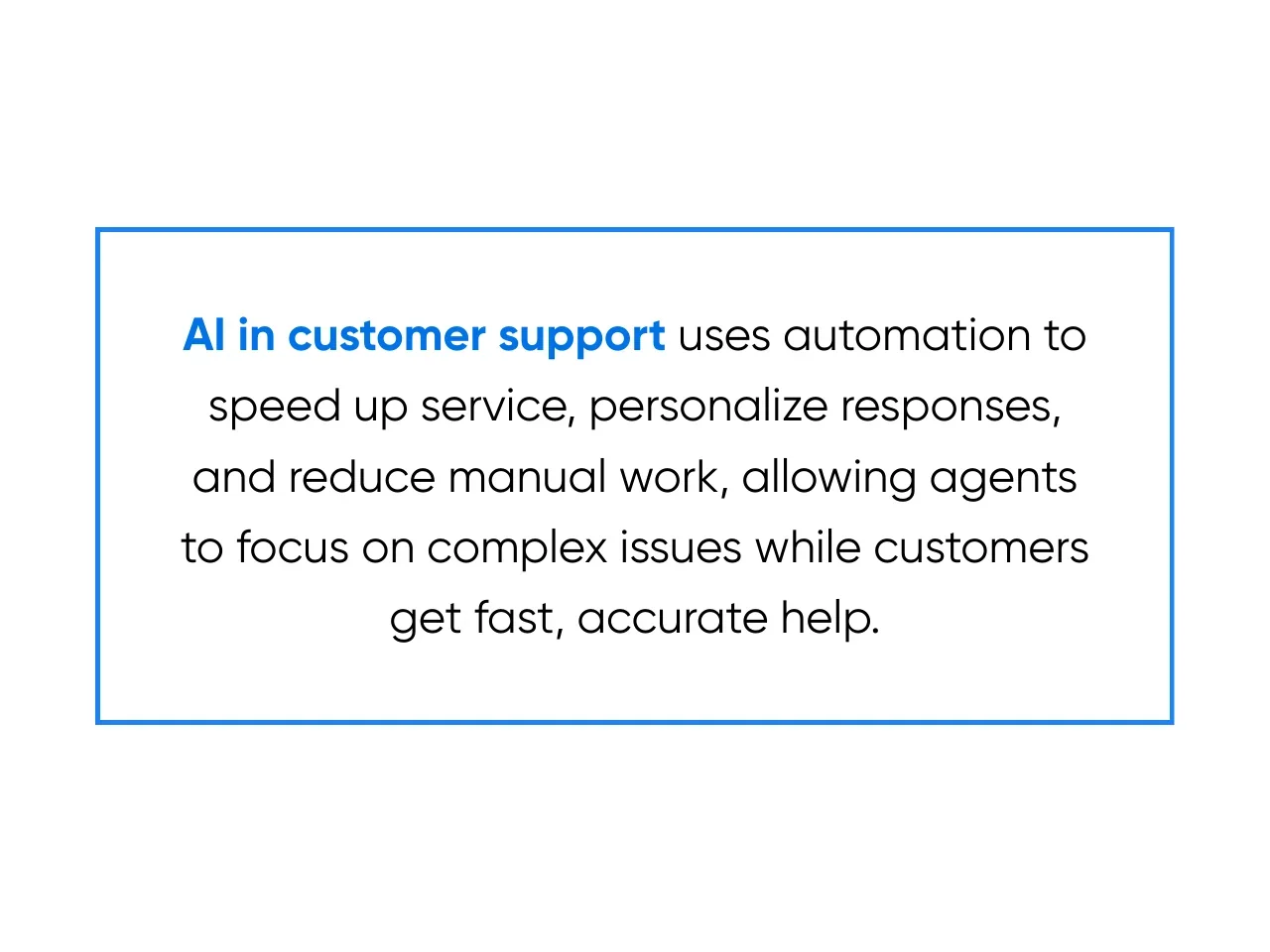
AI in customer support uses artificial intelligence and automation to speed up service, provide instant help, and personalize responses with less manual work. AI-powered customer support tools streamline interactions so your agents can focus on complex issues while customers get quick, accurate answers.
In practice, that means chatbots that can answer “Where’s my order?” at midnight, routing engines that know which agent solved a similar issue last week, or an AI assistant that drafts a reply so your rep just adds the human touch. These tools work with your team, not instead of them, and they scale easily when demand spikes.
Most teams we see start small, like automating FAQs on chat or tagging emails so nothing gets lost. As your team sees the time savings and wins, you can add voice support or proactive outreach. The trick is to match the technology to your real challenges.
Understanding AI’s Role in Modern Customer Support
AI gets hyped like it’s magic, but the real value is much more grounded: it helps your team do better work. It automates routine tasks like tagging support tickets and handling routine inquiries, spots patterns in historical data, and gives agents context to personalize customer interactions. It’s there to amplify your team, not push them aside.
Core AI Technologies in Support
You’ve likely bumped into these tools before. They’re just smarter and better connected now:
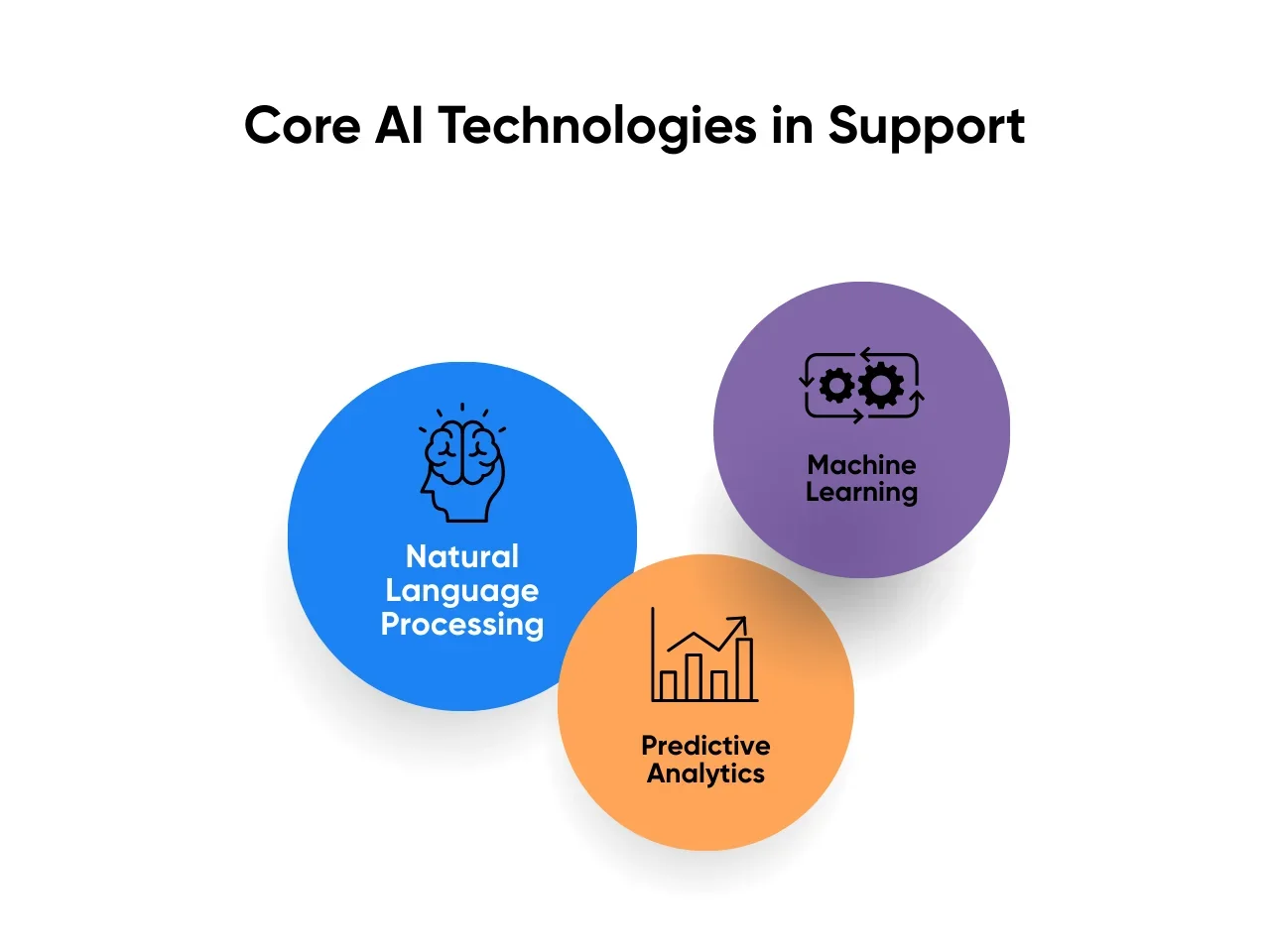
- Natural Language Processing (NLP): This helps AI understand the meaning behind what customers say. For example, an NLP-enabled chatbot can treat “Where’s my order?” and “My package still isn’t here” as the same issue, and route it accordingly. You wouldn’t have to create the same workflow over and over again simply because customers ask the question differently.
- Machine Learning: AI can learn from support history to improve decision-making over time. It might route billing queries about “late fees” to the team that historically handles them fastest, or suggest fixes that solved similar “login failure” cases in the past. This will reduce your training time and effort.
- Predictive Analytics: Smart AI systems can spot surges in traffic that follow certain events and help you staff up, update help docs, or prepare templated responses before tickets hit.
These tools are already empowering platforms like Salesforce and Intercom. IBM even cites how their AI models can learn from behaviors and outcomes to route tickets more effectively and gave one global client a 33% boost in agent efficiency with average wait times down to just 33 seconds. You may not be running a business as big as Salesforce and IBM, but that’s the kind of leverage that AI has potential for in customer relations.
Key Benefits and Limitations of AI in Customer Service
When AI tackles your most stubborn pressure points, the payoff shows up fast and in ways your KPIs will notice:
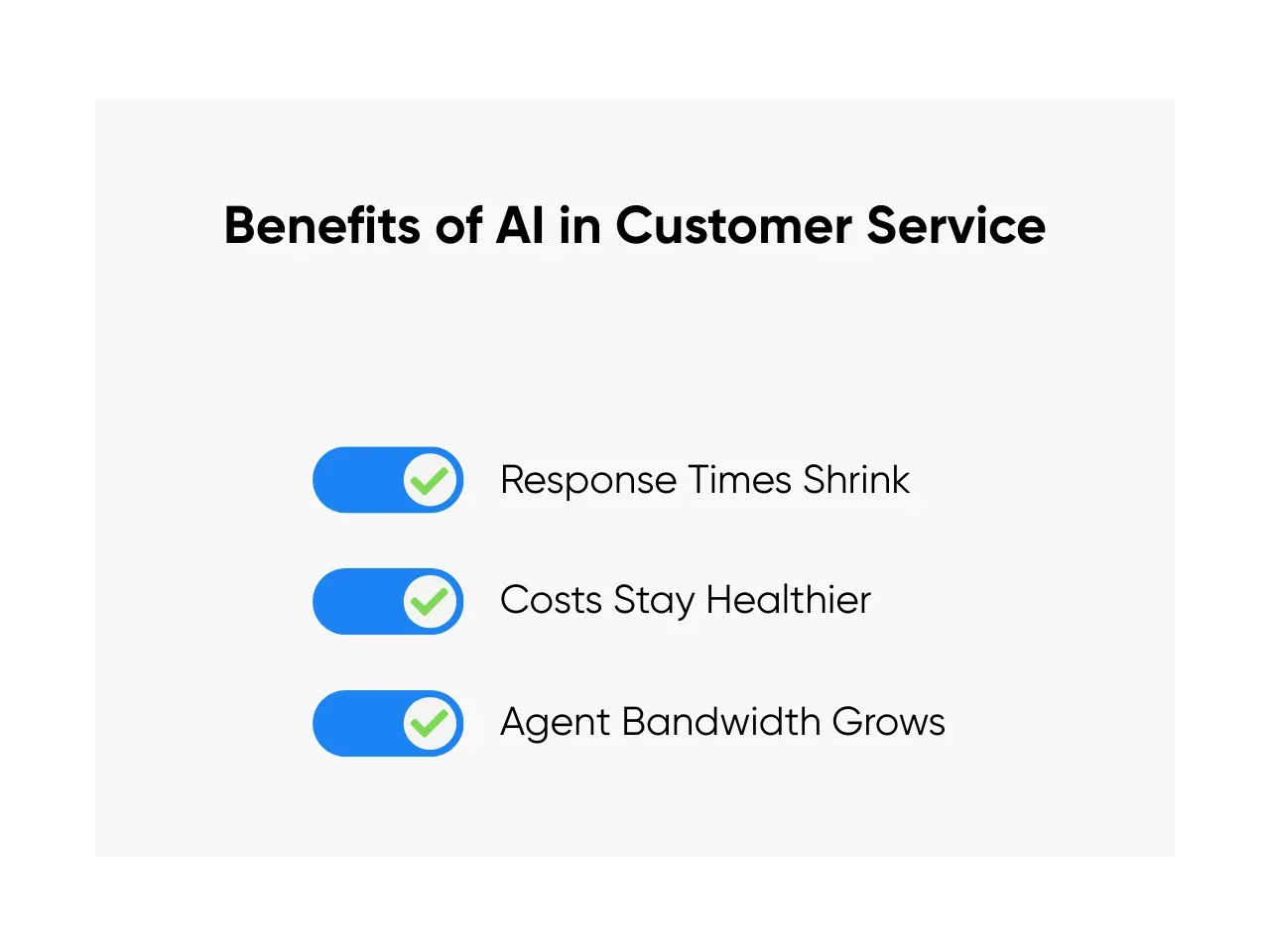
- Response times shrink: Automating routine requests like shipping-status checks or password resets clears queues faster. Zendesk notes that intelligent triage can save agents 30–60 seconds per ticket by automatically tagging and routing based on intent or sentiment. That time adds up quickly across hundreds of daily tickets.
- Costs stay healthier: Offloading high-volume, low-effort questions like “What’s my balance?” or “When do you close?” frees your team to focus on higher-value interactions. That means fewer seasonal hires or overtime costs when ticket volume spikes.
- Agent bandwidth grows: Drafted replies and next-best-action suggestions keep your team working on nuanced problems instead of copy-pasting stock answers. When bots handle FAQs and tagging, your agents can zero in on situations that need empathy and judgment. For example, calming a long-time customer who’s upset after three failed deliveries or helping someone unravel a billing issue that doesn’t fit any standard policy. Those moments build trust and often lift team morale while reducing turnover.
The limits of AI are usually set by how you trained the model. For example, when a customer requests a refund, a bot can simply direct them to your refund policy. But you can also train it to detect customer sentiments and direct those that seem frustrated to a human. That extra step can make a significant difference in the customer experience.
So how can we pair these benefits of AI with a deliberate game plan? You’d need to assess where they’re a good fit and then introduce specific change to your current team’s workflow. We’ll walk you through in detail.
Step 1: Assess Your Support Operation’s AI Readiness
Rolling out AI without a clear picture of where you stand is like trying to fix a leaky faucet in the dark. Before you buy tools or promise timelines, you need a grounded view of your tech stack and team dynamics. Two areas matter most: your infrastructure and your people.
Technical Infrastructure Assessment
Start by asking: Can your systems talk to each other and handle the data AI needs? Look at:
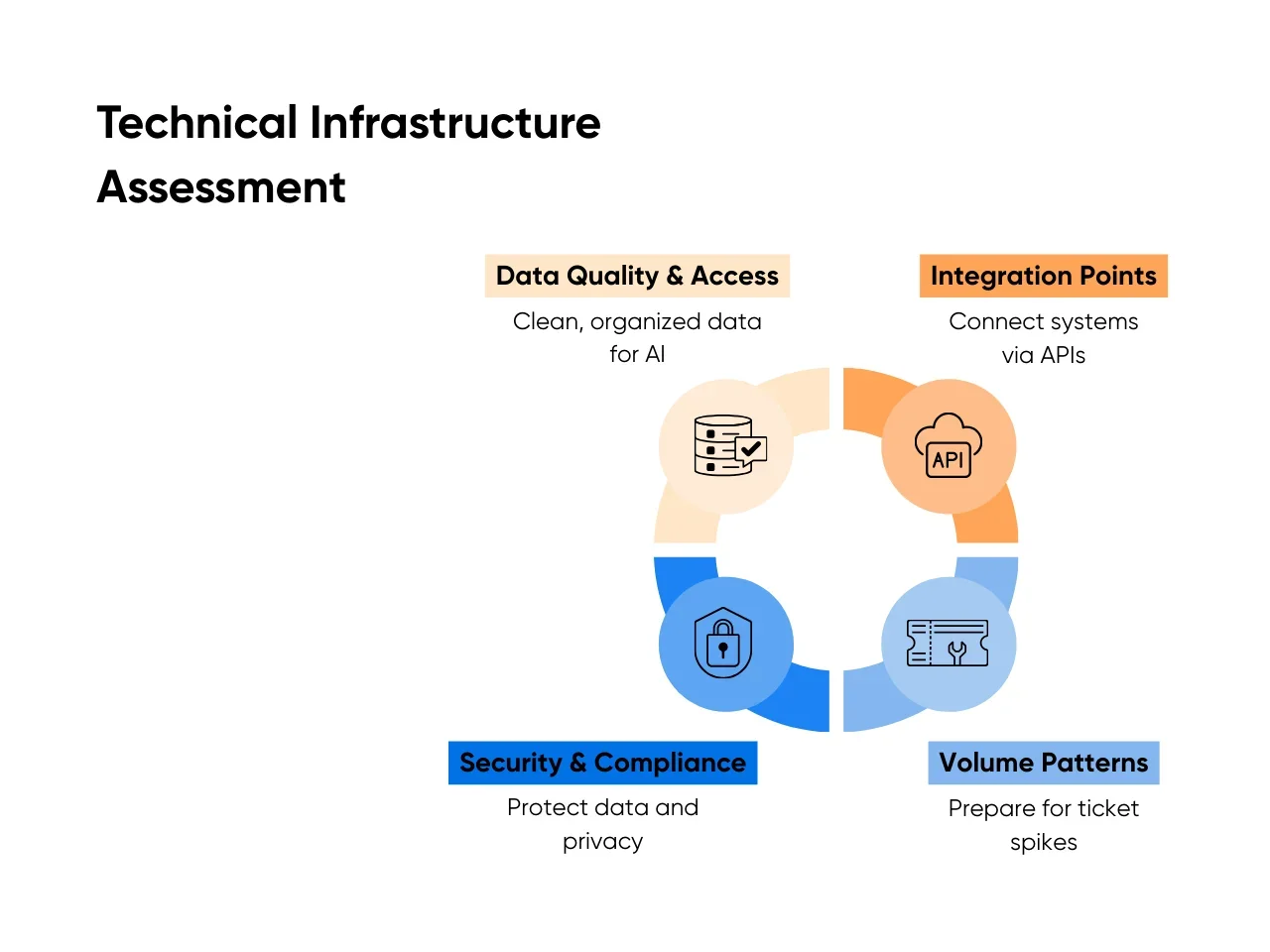
- Data Quality and Access: Do you have clean ticket history, knowledge base articles, and customer profiles stored in a way AI can use? A bot can’t suggest fixes if your past resolutions are scattered across inboxes.
- Integration Points: Check whether your CRM, help desk, and chat tools have APIs or connectors. Without them, you’ll spend months building bridges instead of solving customer issues.
- Volume Patterns: Know your peaks. If ticket volume doubles during product launches, you’ll need scalable cloud infrastructure to support AI workloads.
- Security and Compliance: AI thrives on data, but you must meet privacy regulations. Audit how customer information flows today and what safeguards exist.
To make this actionable, create an audit checklist with these criteria and score each on a 1–5 scale. Many companies uncover gaps, like unstructured ticket histories or missing API access, that need attention before any AI rollout. It’s easier to fix these upfront than mid-project when deadlines loom.
Here’s an example of a simple readiness table you can adapt for your team:
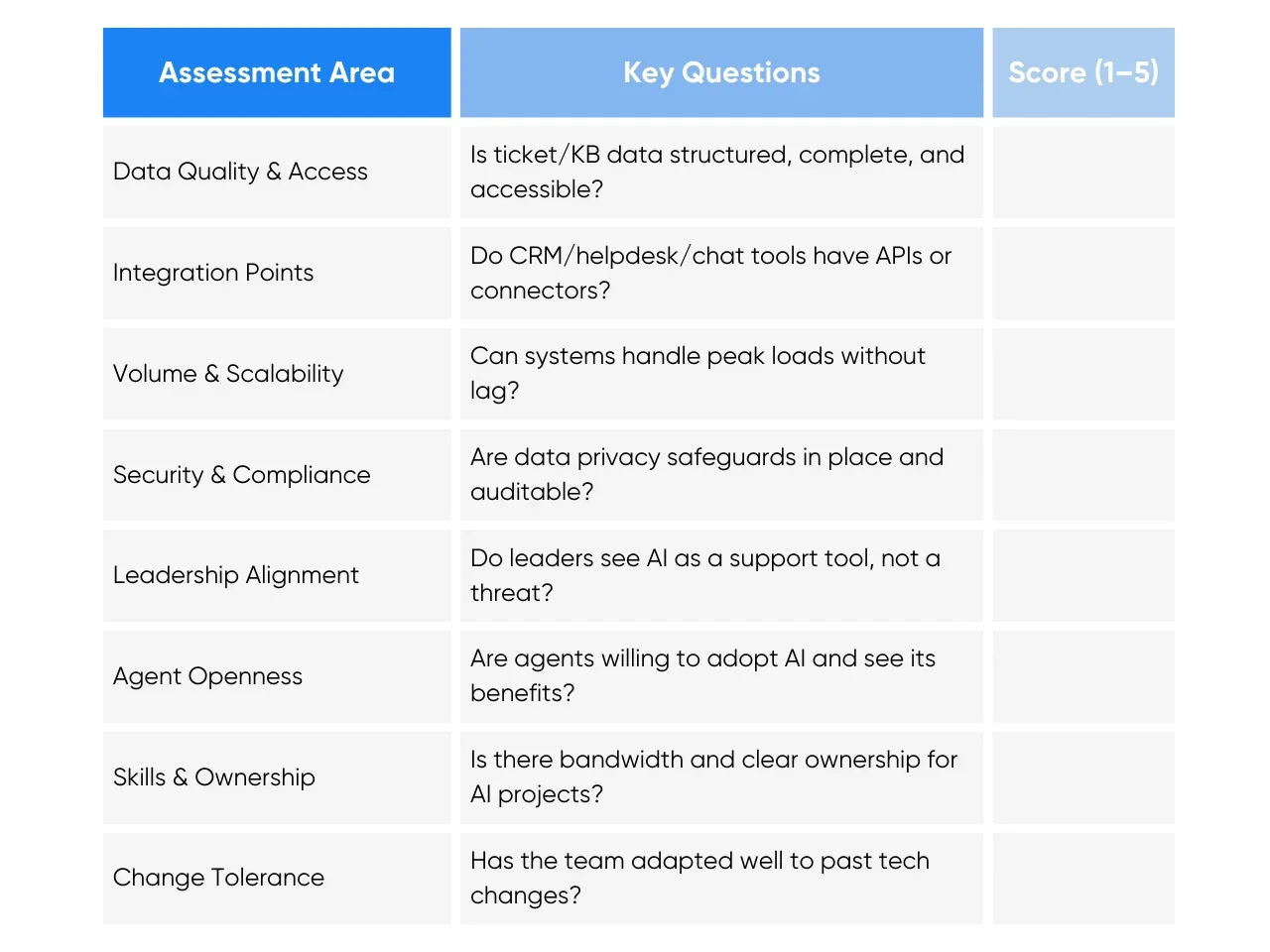
A low score doesn’t mean you can’t proceed; it tells you where to focus first.
Organizational Readiness Evaluation
Even the best tech flops if your team isn’t ready. Gauge where your people stand:
- Leadership Alignment: Do your managers see AI as a support tool or a threat? Misalignment here kills projects.
- Agent Openness: Survey or hold workshops to understand concerns. Are they worried about job security, or do they see AI as a way to ditch repetitive work?
- Skills and Bandwidth: Who will own the AI project internally? If your ops lead is already maxed out, you’ll need external support or a phased timeline.
- Change Tolerance: Look at your track record with new tools. Did your last CRM upgrade go smoothly or spark months of resistance?
According to Atlassian’s guide on AI implementation, companies that succeed often start with small pilots in one support channel and expand only after validating results and gathering team feedback. This gradual approach allows for early wins and helps build buy-in while ironing out technical kinks.
When you know both your technical and organizational baseline, prioritization gets clearer. Maybe you need to clean and centralize customer data before any chatbot pilot. Or you might have solid data but a skeptical team, meaning your first investment is agent workshops, not software.
Doing this homework keeps you from overpromising or misplacing resources. It also lays the foundation for the steps ahead: choosing the right solutions, integrating them smoothly, and scaling without chaos. The teams that skip this step often end up circling back later, but you can save yourself that detour.
Step 2: Select the Right AI Support Solutions
Once you know where you stand, the next question is simple but tricky: which AI tools actually fit your team and customers? The market is full of platforms, but not all of them solve your pain points. Your goal is to pick solutions that hit your top KPIs without overcomplicating workflows.
Solution Types and Use Cases
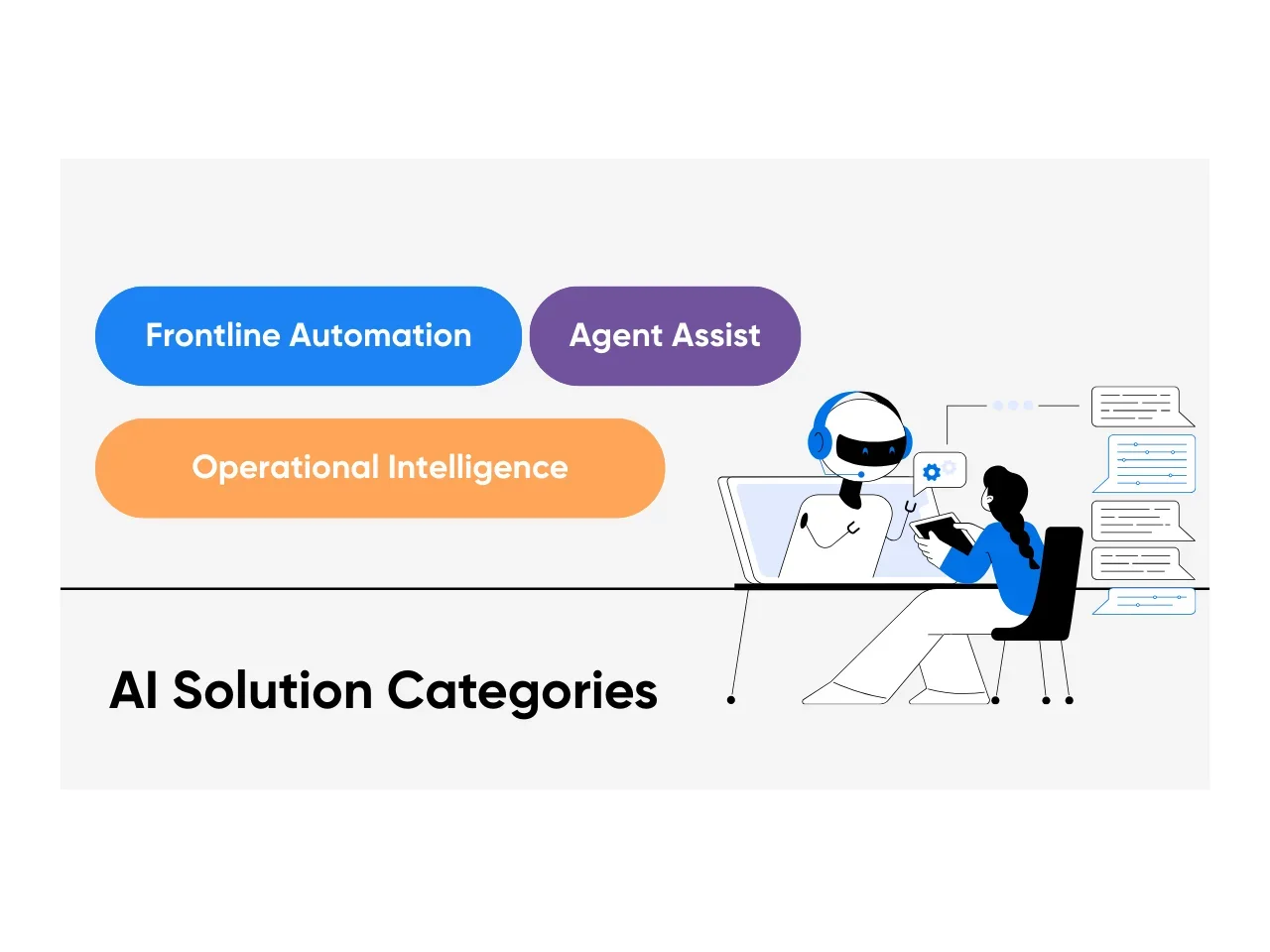
Start with the gaps you uncovered in Step 1. If response times are lagging because agents spend hours tagging tickets, look for AI routing engines that auto-classify and send cases to the right queue. If your backlog is full of “Where’s my order?” emails, a chatbot or virtual assistant can resolve those instantly without adding headcount.
A helpful way to narrow options is to bucket them into three categories:
- Frontline Automation: Virtual agents that provide instant support for FAQs, process customer requests 24/7, or handle customer queries on social media. For instance, some companies are now using specialized tools like OnlyFans AI Chatbot to handle messaging automatically, demonstrating how AI chatbots can scale across niche platforms while maintaining personalized engagement.
- Order Status: Pulls tracking info directly from your commerce API and returns ETAs automatically.
- Password Resets: Verifies identity, sends secure reset links, and logs the outcome without agent effort.
- Returns/RMA: Checks eligibility, issues labels, and updates tickets instantly.
- Appointment Changes: Offers new time slots, books or reschedules, and sends confirmations.
- Outage Updates: Shares real-time status while collecting impact details for ops.
- Agent Assist: Tools that draft replies, suggest relevant responses for human support to personalize, or surface customer history so agents don’t dig through multiple systems.
- Suggested Replies: Drafts responses from prior tickets and knowledge articles for quick edits.
- Thread Summaries: Condense long email chains so agents have context at a glance.
- Field Extraction: Captures order IDs or error codes and auto-fills ticket fields.
- Next-Best Action: Recommends fixes based on similar resolved cases.
- Sentiment Alerts: Flags frustration and prompts escalation before an issue blows up.
- Operational Intelligence: Analyzes customer behavior trends in historical data to predict customer needs and manage operational costs.
- Volume Forecasting: Predicts spikes after launches or promos so you can staff early.
- Topic Clustering: Groups new issues to guide knowledge base updates.
- SLA Risk: Flags tickets likely to breach SLAs so leads can reassign.
- Backlog Heatmaps: Shows bottlenecks by intent, channel, or product line.
- Churn Risk Signals: Surfaces accounts with repeated negative contacts for proactive outreach.
Pick one category that addresses your biggest bottleneck first. You can layer others later. For example, a mid-sized retailer might integrate a simple order-tracking bot with its help desk. Within weeks, it would have resolved nearly half of repetitive “where’s my package” tickets and freed agents to focus on returns and sizing questions where human empathy mattered.
Vendor Selection Framework
After you identify which solution type addresses your priority pain point, evaluate vendors systematically. Go beyond shiny features and drill into:
- Must-Have Features:For Chatbots: Multi-turn dialogs, human handoff, context retention, multilingual support, and confidence thresholds.For Email Automation: Intent detection, auto-tagging, draft suggestions, and safe fallback rules.For Voice AI: Accurate transcription, low latency, caller authentication, PCI redaction, and call summaries.
- For Chatbots: Multi-turn dialogs, human handoff, context retention, multilingual support, and confidence thresholds.
- For Email Automation: Intent detection, auto-tagging, draft suggestions, and safe fallback rules.
- For Voice AI: Accurate transcription, low latency, caller authentication, PCI redaction, and call summaries.
- Integration Capabilities: Native connectors for your CRM/help desk, REST APIs/webhooks for custom events, and knowledge base ingestion. Make sure it supports SSO and maps customer identity cleanly across systems.
- Customization and Training: Ability to fine-tune on your ticket data, workflows, and brand voice.
- Scalability: Confirm the platform handles peak-season spikes and future growth without performance drops.
- Data Privacy and Compliance: Meet GDPR/CCPA and ask how data is stored, redacted, and used for model training.
- Pricing and Total Cost of Ownership: Understand licensing (per seat, per conversation), implementation, data prep, ongoing training, and support costs. Model costs over 12 months under low, expected, and peak scenarios.
- Reporting and Analytics: Confirm it provides KPI-level metrics like first-response time, CSAT, and cost per ticket.
Bring sample tickets to demos and watch how each tool performs with your data. If a vendor can’t demonstrate value on your actual use cases, keep looking.
This is also where partnering with specialists can help. Aloa works with support teams to build custom AI solutions that fit into existing workflows without bloated features or costly missteps. From chatbots and natural language processing to predictive analytics, our phased rollout approach helps you prove ROI before scaling.
Common AI implementation pitfalls include buying an all-in-one AI suite before you’re ready or skipping the data prep needed to make AI effective. Teams that succeed start with what matters most, keep their evaluation criteria tight, and focus on augmenting agents rather than replacing them.
Step 3: Implementation and Integration Strategy
Buying an AI tool is the easy part. The real challenge is weaving it into your day-to-day without slowing everyone down. You need a plan that proves value early, earns your team’s trust, and scales on solid ground. Let’s break it down into two parts: the technical steps to slot AI into your workflows and the change management moves that keep your people on board.
Technical Integration Steps
Skip the big-bang launch. Start with one team, one use case, and one channel. For example, you could roll out an AI assistant that handles only password reset requests in your email queue or tracks online orders in chat. Within a month, it could clear hundreds of those repetitive tickets without touching your phone or social channels. Once you see the impact, expand to other areas.
From there, tackle integration step by step:
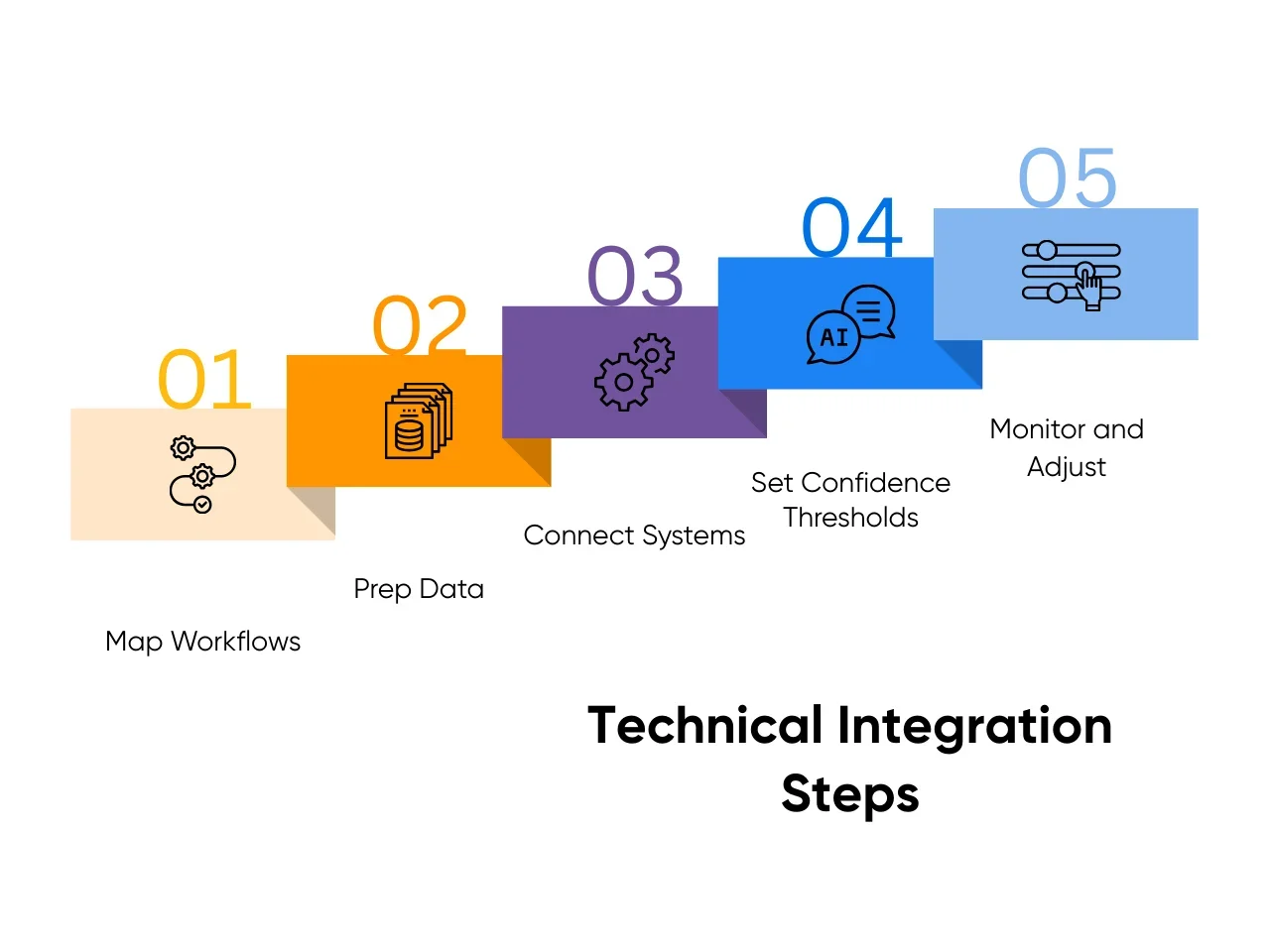
- Map workflows: Document how tickets currently flow across channels. Identify where AI will plug in, whether auto-tagging, routing, drafting replies, or deflecting FAQs.
- Prep data: Clean up your knowledge base and ticket history. AI is only as good as the data it’s trained on; outdated FAQs or mislabeled tickets lead to bad predictions.
- Connect systems: Use APIs or native integrations to link AI with your CRM, help desk, and analytics. Test on sample tickets to ensure context passes cleanly (customer history, sentiment, priority).
- Set confidence thresholds: Decide when AI acts automatically and when it should hand off to a human. For example, route low-confidence chatbot queries directly to an agent instead of guessing.
- Monitor and adjust: Run the pilot for a defined period (4–6 weeks) and track KPIs like response time, resolution rate, and deflection. Tweak prompts, routing rules, or knowledge gaps before expanding.
A phased approach keeps risk low and confidence high. Teams like Atlassian stress that starting small helps you iron out issues before they ripple across all channels.
Change Management Process
Technology is only half the battle; people are the other half. Your agents need to see AI as a helper, not a threat. Change management is what makes that possible:
- Communicate the purpose: Share what problem the AI pilot solves and how it helps agents (less repetitive work, faster answers, fewer weekend backlogs).
- Bring agents into testing: Let them test the tools, give feedback, and shape workflows. When they help design the rollout, adoption jumps.
- Train for collaboration: Focus training on when and how to trust AI suggestions and when to step in manually. Role-play tricky scenarios so agents know they’re still in control.
- Set realistic expectations: AI won’t be perfect on day one. Prepare the team for iteration, not instant magic. Celebrate quick wins along the way to build trust.
Without this cultural groundwork, even well-built tech will struggle. Successful rollouts pair process change with people readiness so adoption feels natural, not forced.
Success Metrics to Track
Measure impact early and often so you know what’s working and what’s not. Key metrics include:
- Response and Resolution Times: How much faster are tickets cleared compared to baseline?
- Deflection Rates: Percentage of inquiries resolved by AI without agent involvement.
- CSAT: Are customers as happy (or happier) when AI is in the mix?
- Agent Satisfaction: Anonymous surveys post-pilot help catch morale trends and surface friction points.
- Cost per Ticket: Are you reducing handling costs without sacrificing service quality?
Use these metrics as your north star for deciding when and how to scale. If the pilot meets success thresholds, you can expand to new channels or use cases backed by proven results.
Bringing in experienced partners can make all the difference. Aloa helps support organizations roll out AI without the guesswork, including cleaning data, integrating with your existing tools, and coaching your agents through the shift. Our phased approach makes sure you see measurable wins before expanding, so AI becomes a seamless part of your operations rather than a risky overhaul.
Step 4: Training and Optimization
Getting AI live is one milestone; keeping it sharp is where the real work (and payoff) happens. Think of AI like a talented new hire: you wouldn’t hand them a headset and walk away. You’d coach, check in, and give them better tools as your business evolves. AI is no different.
How to Continuously Improve AI-Powered Customer Support
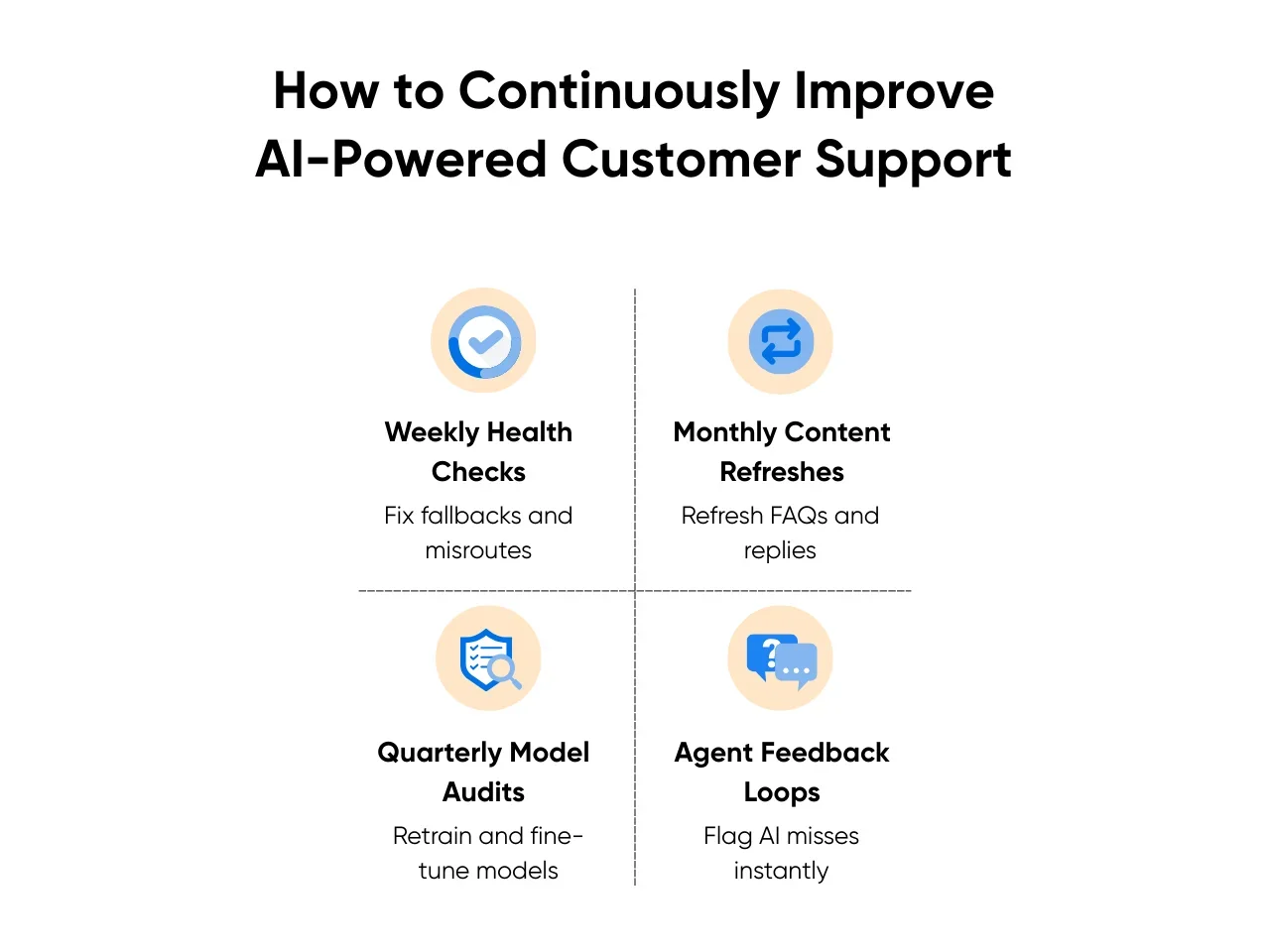
AI thrives on fresh input. If your knowledge base or ticket tags get stale, its accuracy and value drop fast. Build regular tune-ups into your operations so performance improves instead of sliding backward:
- Weekly Health Checks: Look at chatbot fallbacks, misrouted tickets, and escalations. Ask why they happened. Did a product name change? Is the bot missing context for a certain request? Quick fixes here keep the customer experience tight.
- Monthly Content Refreshes: Products, policies, and promotions shift. Update FAQs and canned replies so the AI always reflects the latest information.
- Quarterly Model Audits: Retrain models with fresh customer language and recent support cases. Review how the AI classifies intent or sentiment and fine-tune thresholds if needed.
- Agent Feedback Loops: Make it easy for agents to flag AI misses or opportunities in real time. They see the edge cases first and know where friction happens.
A phased approach helps you add capacity without breaking what works. Many companies share their playbooks publicly; for instance, Aloa’s AI in Customer Service resource highlights examples of how different industries layer AI features over time without overloading teams.
These rhythms keep your AI aligned with your business and your customers’ evolving needs. When teams treat optimization as an ongoing habit, AI becomes more reliable and more trusted by agents and customers alike.
Key KPIs to Track
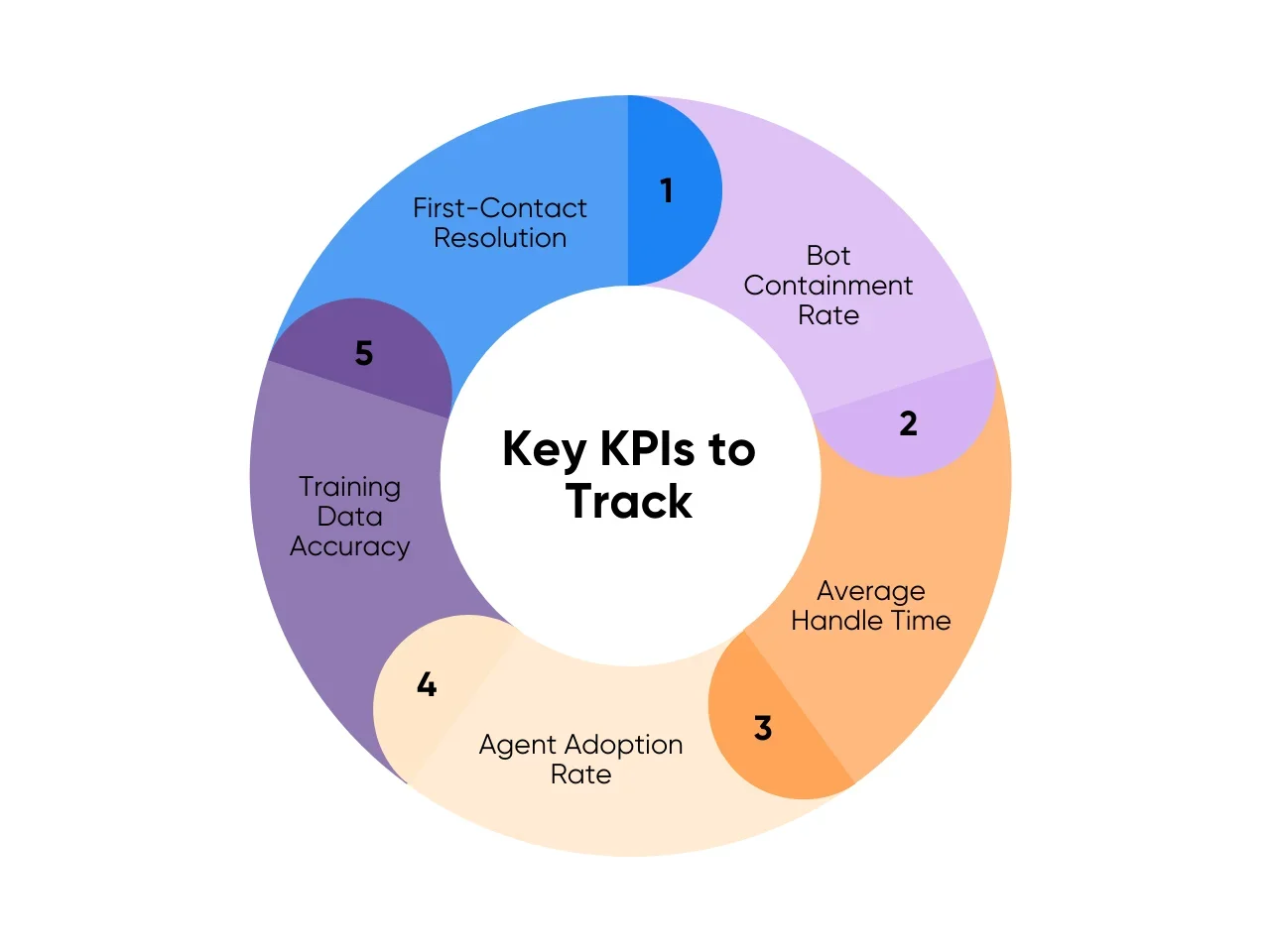
You can’t optimize what you don’t measure. Beyond the pilot-phase metrics like response and resolution times, add KPIs that reflect how well AI is performing long term:
- First-Contact Resolution (FCR): Is AI helping customers get their issue handled the first time without bouncing between channels?
- Bot Containment Rate: What percentage of tickets are fully resolved without agent intervention? This helps you see where automation is working and where it’s falling short.
- Average Handle Time (AHT): When AI suggests responses or surfaces context, does it actually shorten call and chat durations?
- Agent Adoption Rate: Are your people using the AI features built for them (like suggested replies)? Low usage can point to poor workflow fit or inadequate training.
- Training Data Accuracy: How often do supervisors or customer service agents need to override AI responses? A spike here can signal your knowledge base needs updating.
Tracking these KPIs gives you both early warning signs and evidence of ROI. Pair the data with your agent feedback for the full picture.
Common Optimization Challenges and Fixes
Even teams that start strong run into hurdles. Here are some you’ll likely face and how to handle them:
- Model Drift: Over time, customer language and issues change. Retrain regularly to prevent accuracy drop-offs.
- Over-Automation: Too much bot, not enough human. Always offer an easy “talk to a person” path so customers don’t feel trapped.
- Scaling Blind Spots: Expanding AI into a new channel without a pilot can create inconsistent experiences. Test and monitor before rolling out broadly.
- Agent Disengagement: If agents feel AI is “policing” them or doesn’t make their day easier, adoption plummets. Share wins like time saved and reduced weekend backlogs to keep morale high.
The key is accepting that optimization is a loop, not a one-and-done project. Each improvement feeds the next and keeps AI relevant and useful over the long haul.
Key Takeaways
AI-powered customer support delivers the most impact when it’s approached with focus and intent, not just excitement over new tech. At its core, success rests on four practical moves:
- Assess readiness: Identify your tech and team gaps before investing.
- Target specific pain points: Target costly pain points like slow responses or repetitive tickets.
- Integrate in phases: Clean your data, pilot one use case, and build trust before scaling.
- Keep tuning: Refresh content, retrain models, and track KPIs so AI keeps delivering.
Some leaders hesitate, worried that automation could hurt service quality or morale. But those risks only arise when AI replaces judgment instead of supporting it. Involve your team, start with one high-volume pain point, measure the impact, and expand from there.
Aloa’s AI development services help support teams roll out AI in customer support with clear roadmaps and seamless integrations. When you’re ready to explore what this could look like for your organization, book a consultation with us to start building a support operation that runs smarter!

